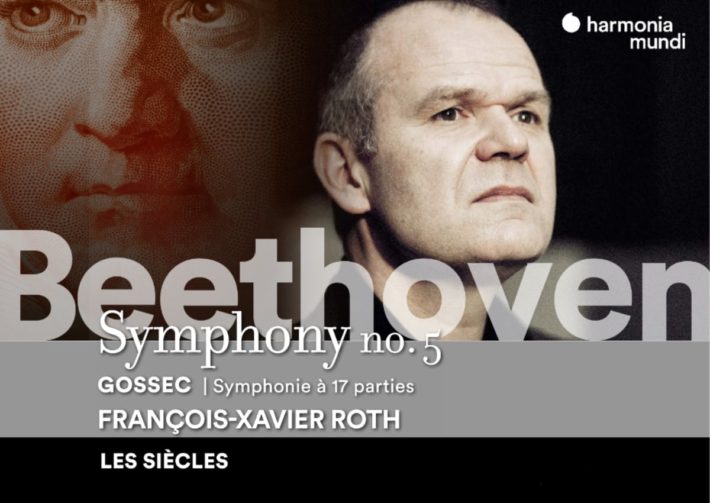The search for the authentic sound from the time of a composer is always a controversial subject with listeners. Up until a few years ago, François-Xavier Roth Les Siècles had a reputation for recording music chiefly around the Belle Époque era on original instruments. Their latest Harmonia Mundi release – part of the label’s ongoing series that presents a large work by Beethoven alongside one of his contemporaries – takes them back much further, pairing Beethoven’s Fifth Symphony with a rarity of 1809 — Gossec’s “Symphonie à 17 Partie”.
Discussing Beethoven’s Fifth, there is a recording out there now to suit every taste. What does Roth do here to make his account stand apart in a crowded market? Firstly, it’s the sound of Les Siècles. The orchestra players push the instruments to their limits, giving Roth everything he commands. The gut strings have a quality all of their own – the almost raw sound is as full-bodied as the players can manage.
The intonation of the period instruments is very hard to control as securely as modern instruments, but the conviction they are played with is quite endearing, as illustrated by the opening of the second movement. The woodwind timbres have warmth, but lack the penetrating tones of their contemporaries. Clarinets have a voice-like quality; bassoons are rather reedy, but it’s the piccolo in the final movement which, although well played, lacks the piercing quality needed to cut through the sound. That being said, the precision of the articulation is commendable.
Related Classical Music Reviews
- Review: Beethoven – Symphony No. 6 (“Pastoral”) – Akademie für Alte Musik Berlin
- Review: Beethoven – Symphonies No. 5 and 7 – NDR, Manze
- Review: Beethoven – Complete Symphonies – Vienna Philharmonic Orchestra – Nelsons
But first and foremost what sets this performance apart is the interpretation; Roth doesn’t toe the line of convention, but sets his own bar. As with his other releases with Les Siècles, there are moments that thrill with excitement; It’s well-paced and contains features that make any listener familiar with the work listen afresh. Roth takes a more romantic perspective, looking forward in time, taking risks with tempos, rubato, and articulation. He is more involved with the emotional journey and searches for the darker corners rather than highlighting the structural components, as Gardiner and Harnoncourt do so meticulously. This is especially evident in the driven first movement and the mysterious third.
Those familiar with Chandos’ “Contemporaries of Mozart” series will know what a treasure of a disc the Gossec edition is. His “Symphony à Partie 17” is more Mozartian, harking back to the height of the classical period. The music lacks the complexities of Beethoven, something Roth recognizes in his short booklet assay. Given an entirely different compositional approach, this piece is stylistic, but it’s not without the quirks Roth brings, which helps enliven the score. A pleasing listen and a contrasting work to the preceding Beethoven.
Hogwood offers a safe, solid performance of the Beethoven, while Gardiner is more vivacious and polished. Roth pushes the boundaries, just as Beethoven did, to give a reading that is edgy, akin to a rough diamond. The beauty of it can be appreciated but it will most likely divide opinions. Recommended for those looking for a distinctive, unconventional and intriguing Fifth, or with a particular interest in period performance.

Beethoven – Symphony No. 5 in C minor, Op. 67
Gossec – Symphonie à Dix-Sept Parties in F Major, Rh64
Les Siècles
François-Xavier Roth – Conductor
Harmonia Mundi, CD HMM 902423
Recommended Comparisons
Harnoncourt | Gardiner | Hogwood | Brüggen
[the_ad_group id=”226″]
Read more classical music reviews or visit The Classic Review Amazon store
Follow Us and Comment:
Get our periodic classical music newsletter with our recent reviews, news and beginners guides.
We respect your privacy.









